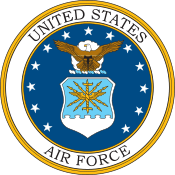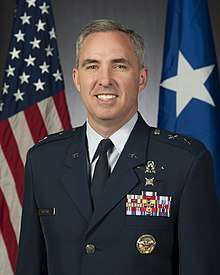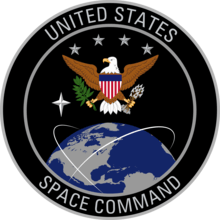Combined Force Space Component Command
The Combined Force Space Component Command (CFSCC) is a U.S.–led multinational subordinate command of United States Space Command. It is responsible for tactical control of American and multinational space forces.
| Combined Force Space Component Command | |
|---|---|
 Combined Force Space Component Command shield | |
| Founded | 29 August 2019; 7 months |
| Country | |
| Type | Subordinate command |
| Role | Tactical control of space forces |
| Size | 17,000 personnel [1] |
| Part of | |
| Headquarters | Vandenberg AFB, California, U.S. [1] |
| Commanders | |
| Commander | |
| Deputy Commander | |
| Senior Enlisted Leader | CCM John F. Bentivegna, USAF |
| Insignia | |
| Flag |  |
Mission
The Combined Force Space Component Command's mission is to "plan, integrate, conduct, and assess global space operations in order to deliver combat relevant space capabilities to Combatant Commanders, Coalition partners, the Joint Force, and the Nation."[3]
Structure
The Combined Force Space Component Command's includes four integral components:




History
The Combined Force Space Component Command was established immediately after the establishment of United States Space Command on August 29, 2019. In addition to having tactical control of Air Force, Army, Navy, and multinational forces, the CFSCC also plans and executes space operations. Specifically, the CFSCC works to both execute space operations and integrate space effects and support within the existing combatant commands. The CFSCC also provides support to, and receive support from, Coalition operations centers including the Australian Space Operations Center, Canadian Space Operations Center, and United Kingdom Space Operations Center. In addition it executes command and control of assigned multinational forces in support of Operation Olympic Defender.
The CFSCC specifically commands space domain awareness, space electronic warfare, satellite communications, missile warning, nuclear detonation detection, environmental monitoring, military intelligence, surveillance, and reconnaissance, navigation warfare, command and control, and positioning, navigation, and timing.[1]
A ceremony recognizing the establishment of the CFSCC occurred on October 1, 2019 at Vandenberg AFB.[4]
Commanders
| No. | Portrait | Name | Term | Service branch | Deputy Commander | Senior Enlisted Leader | ||
|---|---|---|---|---|---|---|---|---|
| Took office | Left office | Duration | ||||||
| 1 | Major General Stephen N. Whiting | 29 August 2019 | 20 November 2019 | 83 days |  U.S. Air Force | Brigadier General Matthew Wolfe Davidson | Chief Master Sergeant John F. Bentivegna | |
| 2 | Major General John E. Shaw | 20 November 2019 | Incumbent | 188 days |  U.S. Air Force | Brigadier General Matthew Wolfe Davidson | Chief Master Sergeant John F. Bentivegna | |
References
- "Combined Force Space Component Command Established at Vandenberg AFB > Schriever Air Force Base > Article Display". Schriever.af.mil. Retrieved 2020-01-21.
- https://www.vandenberg.af.mil/Units/Space-Operations-Command/
- "United States Space Command Fact Sheet > United States Space Command > Fact Sheets Editor". Spacecom.mil. 2019-08-29. Retrieved 2020-01-21.
- "Military leaders unveil new space command at Vandenberg Air Force Base | Military Council". Militarycouncil.ca.gov. 2019-10-01. Retrieved 2020-01-21.


